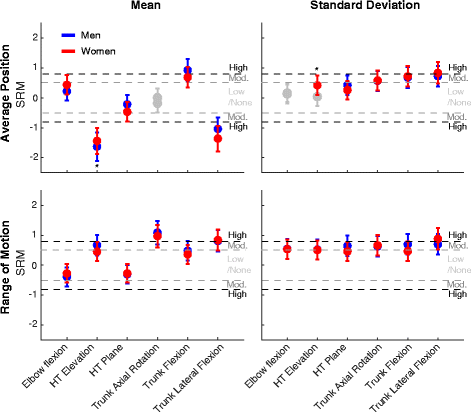Sex differences in kinematic adaptations to muscle fatigue induced by repetitive upper limb movements
- PMID: 29673397
- PMCID: PMC5907702
- DOI: 10.1186/s13293-018-0175-9
Sex differences in kinematic adaptations to muscle fatigue induced by repetitive upper limb movements
Abstract
Background: Muscle fatigue induced by repetitive movements contributes to the development of musculoskeletal disorders. Men and women respond differently to muscle fatigue during isometric single-joint efforts, but sex differences during dynamic multi-joint tasks have not been clearly identified. Moreover, most studies comparing men and women during fatigue development assessed endurance time. However, none evaluated sex differences in kinematic adaptations to fatigue during multi-joint dynamic tasks. The objective of the study was to compare how men and women adapt their upper body kinematics during a fatiguing repetitive pointing task.
Methods: Forty men and 41 women performed repetitive pointing movements (one per second) between two targets while maintaining their elbow elevated at shoulder height. The task ended when participants rated a perceived level of fatigue of 8/10. Trunk, humerothoracic, and elbow angles were compared between the first and last 30 s of the experiment and between men and women. Linear positions of the index finger (distance from the target) and the elbow (arm elevation) as well as movement timing were documented as task performance measures.
Results: Men (7.4 ± 3.2 min) and women (8.3 ± 4.5 min) performed the repetitive pointing task for a similar duration. For both sex groups, trunk range of motion increased with fatigue while shoulder's and elbow's decreased. Moreover, participants modified their trunk posture to compensate for the decreased humerothoracic elevation. Movements at all joints also became more variable with fatigue. However, of the 24 joint angle variables assessed, only two Sex × Fatigue interactions were observed. Although average humerothoracic elevation angle decreased in both subgroups, this decrease was greater in men (standardized response mean [SRM] - 1.63) than in women (SRM - 1.44). Moreover, the movement-to-movement variability of humerothoracic elevation angle increased only in women (SRM 0.42).
Conclusion: Despite many similarities between men's and women's response to fatigue induced by repetitive pointing movements, some sex differences were observed. Those subtle differences may indicate that men's shoulder muscles were more fatigued than women's despite a similar level of perceived exertion. They may also indicate that men and women do not adapt the exact same way to a similar fatigue.
Keywords: Adaptation; Fatigue; Gender; Kinematics; Musculoskeletal disorders; Sex differences; Shoulder; Upper limb.
Conflict of interest statement
Ethics approval and consent to participate
The protocol was approved by the ethics committee of the Center for Interdisciplinary Research in Rehabilitation of Greater Montreal. All participants gave written consent.
Competing interests
The authors declare that they have no competing interests.
Publisher’s Note
Springer Nature remains neutral with regard to jurisdictional claims in published maps and institutional affiliations.
Figures





Similar articles
-
Similar effects of fatigue induced by a repetitive pointing task on local and remote light touch and pain perception in men and women.PLoS One. 2020 Dec 18;15(12):e0244321. doi: 10.1371/journal.pone.0244321. eCollection 2020. PLoS One. 2020. PMID: 33338075 Free PMC article.
-
Upper extremity kinematic and kinetic adaptations during a fatiguing repetitive task.J Electromyogr Kinesiol. 2014 Jun;24(3):404-11. doi: 10.1016/j.jelekin.2014.02.001. Epub 2014 Feb 13. J Electromyogr Kinesiol. 2014. PMID: 24642235 Clinical Trial.
-
Sex-specific effects of localized muscle fatigue on upper body kinematics during a repetitive pointing task.BMC Musculoskelet Disord. 2022 Jun 27;23(1):613. doi: 10.1186/s12891-022-05566-5. BMC Musculoskelet Disord. 2022. PMID: 35761276 Free PMC article.
-
The Response of the Shoulder Complex to Repetitive Work: Implications for Workplace Design.Crit Rev Biomed Eng. 2015;43(1):21-32. doi: 10.1615/critrevbiomedeng.2015014059. Crit Rev Biomed Eng. 2015. PMID: 26351021 Review.
-
Multibody Kinematics Optimization for the Estimation of Upper and Lower Limb Human Joint Kinematics: A Systematized Methodological Review.J Biomech Eng. 2018 Mar 1;140(3). doi: 10.1115/1.4038741. J Biomech Eng. 2018. PMID: 29238821
Cited by
-
The effectiveness of the sarcopenia index in predicting septic shock and death in elderly patients with community-acquired pneumonia.BMC Geriatr. 2022 Apr 19;22(1):341. doi: 10.1186/s12877-022-03029-z. BMC Geriatr. 2022. PMID: 35439963 Free PMC article.
-
Data-Driven Approach for Upper Limb Fatigue Estimation Based on Wearable Sensors.Sensors (Basel). 2023 Nov 20;23(22):9291. doi: 10.3390/s23229291. Sensors (Basel). 2023. PMID: 38005677 Free PMC article.
-
Neuromotor variability partially explains different endurance capacities of expert pianists.Sci Rep. 2023 Sep 13;13(1):15163. doi: 10.1038/s41598-023-42408-3. Sci Rep. 2023. PMID: 37704661 Free PMC article.
-
Is sex a proxy for mechanical variables during an upper limb repetitive movement task? An investigation of the effects of sex and of anthropometric load on muscle fatigue.Biol Sex Differ. 2020 Oct 30;11(1):60. doi: 10.1186/s13293-020-00336-1. Biol Sex Differ. 2020. PMID: 33126920 Free PMC article.
-
Similar effects of fatigue induced by a repetitive pointing task on local and remote light touch and pain perception in men and women.PLoS One. 2020 Dec 18;15(12):e0244321. doi: 10.1371/journal.pone.0244321. eCollection 2020. PLoS One. 2020. PMID: 33338075 Free PMC article.
References
-
- Nordander C, Hansson GA, Ohlsson K, Arvidsson I, Balogh I, Stromberg U, Rittner R, Skerfving S. Exposure-response relationships for work-related neck and shoulder musculoskeletal disorders—analyses of pooled uniform data sets. Appl Ergon. 2016;55:70–84. doi: 10.1016/j.apergo.2016.01.010. - DOI - PubMed
-
- Bodin J, Garlantezec R, Costet N, Descatha A, Viel JF, Roquelaure Y. Risk factors for shoulder pain in a cohort of French workers: a structural equation model. Am J Epidemiol. 2017;187(2):206–13. - PubMed
-
- Sarquis LM, Coggon D, Ntani G, Walker-Bone K, Palmer KT, Felli VE, Harari R, Barrero LH, Felknor SA, Gimeno D, et al. Classification of neck/shoulder pain in epidemiological research: a comparison of personal and occupational characteristics, disability, and prognosis among 12,195 workers from 18 countries. Pain. 2016;157(5):1028–1036. doi: 10.1097/j.pain.0000000000000477. - DOI - PMC - PubMed
Publication types
MeSH terms
Grants and funding
LinkOut - more resources
Full Text Sources
Other Literature Sources

